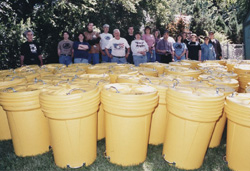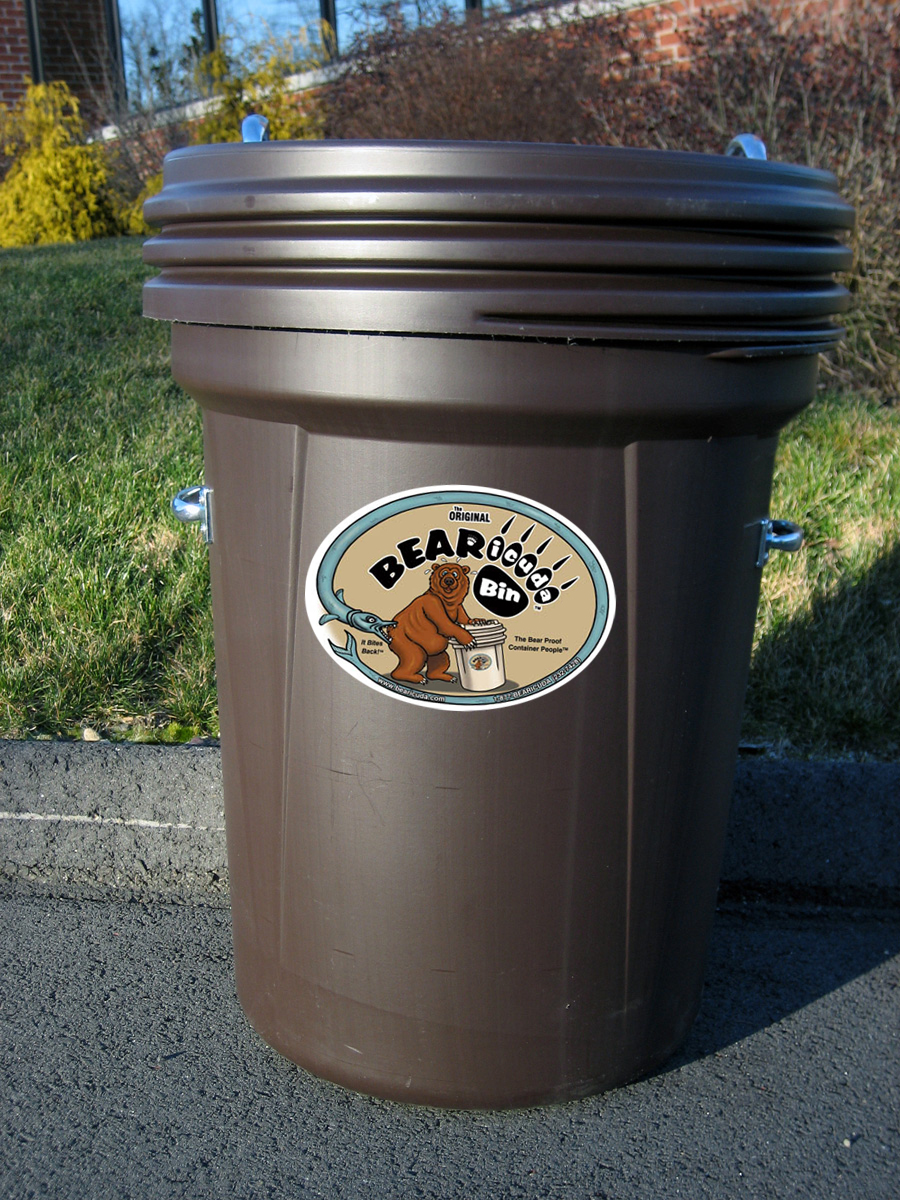| Bear Facts and Tips on Living in Harmony
with Bears |
| There are 3 species of bears in North America, the Polar Bear, the Brown or Grizzly Bear, and the Black Bear. Grizzly bears inhabit areas of northwestern Canada, Alaska, and the Yellowstone area. The only bears in the eastern United States are Black Bears, though some are brown in color.
Normal life span of bears in non-hunted populations can be 25-30 years, while bears in hunted populations may only live 5-6 years.
Black bears establish and occupy territories based on available food supply. Generally, an adult female?s home range will cover 15 square miles; an adult male?s will cover 50-60 square miles. These home ranges overlap those of other bears.
Black Bears are omnivorous, their diet consisting of both animal and vegetable matter; however, roughly 80% of their diet is derived from grasses,
sprouts, succulent greens, berries, seeds and nuts. Insects comprise roughly 15% of their diet, while black bears occasionally eat small mammals and carrion, i.e. road-kill.
Bears are opportunistic feeders, taking advantage of a readily available food source and expending the least amount of energy for the highest caloric intake.
Bears den between November and April. Though their metabolic rates decrease to conserve body fat, they can easily be disturbed and aroused.
Bears may lose 25% of their body weight in the den. Finding good food supplies to fatten-up before denning and to replace lost weight after denning is critical to a bears survival.
Bears den in response to diminished food supply rather than in response to colder weather. Recent studies conclude garbage-conditioned bears den less.
|

(Photo credit: Dale C. Jones)

The Bear Education And Resource Group
(The BEAR Group)
PO Box 918
Hewitt NJ 07421
973-853-BEAR
www.savenjbears.com |
Black bears have good vision, very good hearing, and an extremely keen sense of smell. This combined with their intelligence, excellent memory and extraordinary ability to navigate enables them to
find food sources.
Black bears can quickly climb trees, are good swimmers, and can run 30 mph.
Breeding takes place in June and July, but only sows of sufficient weight and nutritional condition will give birth to cubs while denning in January. Cubs weigh less than 1 pound at birth.
Cubs remain with their mothers for a year and a half and will learn from their mothers how and where to locate food sources.
Unlike Grizzly Bears, black bear mothers seldom defend their cubs from people. If threatened, mother bears send cubs to safety up a tree, and will likely retreat.
Bear-human encounters that result from bears being lured (by the scent of garbage) into neighborhoods often result with a bear being trapped and relocated or with officials killing the "nuisance" bear.
The removal or destruction of a bear will only open-up that territory and its food supply for another bear.
National Parks and a few communities like Gatlinburg Tennessee, SnowMass Colorado and Mammoth Lakes California have successfully reduced "nuisance" bear complaints by strictly enforcing garbage control ordinances and by using Bear Proof Trash Cans.
Black bears are generally active dawn to dusk, traveling throughout their territories to forage on seasonal food supplies, napping at times. Where suburban sprawl has encroached into bear territory, bears may become nocturnal to avoid humans.
It is extremely rare for a black bear to exhibit aggressive behavior toward people. Black bears typically act as prey animals and climb trees to escape danger. Bluff charges are defensive, not offensive behavior.
A fearful bear may make noise by teeth-clacking, jaw-popping, expelling air, and may swat the ground or a tree with her or her paw; but again this is not a sign of impending attack, rather it is a sign the bear is fearful and uncomfortable with the situation. Give the bear an escape route. Never corner a bear.
For each fatality caused by a black bear in all of North America, there are 13 deaths caused by snakes, 45 deaths caused by dogs, 120 deaths caused by bees, and 60,000 homicides in the U.S alone. These statistics are used to demonstrate the rarity of aggressive black bear behavior.
Considering the hundreds of thousands of human-bear encounters, the risk is extremely minimal.
Expansion of human development into bear habitat is bringing bears and
people closer together and increasing the frequency of encounters. Only
public education (to expose the myth of the ferocious black bear), non-lethal
bear management tactics like aversive -conditioning, and serious garbage
control will ensure the future of black bears and provide a means for
peaceful co-existence. Be responsible with your trash?a fed bear
is a dead bear. |
| Tips for Preventing Unwanted Bear Encounters |
- Enclose garbage in an airtight plastic bag and place in a bearproof trash can or bear resistant container.
Keep the garbage can clean and do not store in your garage.
- Keep meat and fish frozen until discarding into trash.
- Remove attractants from your property.
- Feed birds only between November
and April when most bears are denning.
- Birdfeeders should be strung
at least 12? high between sturdy posts or trees, well out of reach of climbing bears.
If the birdseed falls to the ground, clean it up.
- Do not put sweets, meat or fish in compost. Use lime to reduce compost odors.
- Clean barbecue grills after each use.
- Rinse food containers before putting into bear proof trash can or recycling.
- Remove pet food from decks, kennels, and
cages.
- Pick ripe fruit from trees and remove fallen fruit from the ground.
- Do not leave groceries or other attractants in your vehicle.
- Keep garage doors closed to prevent bears from seeking stored birdseed and pet food.
- Use electric fencing to protect caged and penned pets, beehives, and valuable trees.
- Use aversive conditioning tactics to scare bears off property. Loud noises from air horns, marine whistles, or banging pots and pans can scare bears away. Blast bears with a spray from the garden hose or a super-soaker water gun.
- Dominance posturing and vocalizations on your part (wave your arms, stomp your feet, yell at the bear) will teach bears to fear you.
|
|
Learn more about bear biology and behavior from Dr. Lynn
Rogers at: www.bear.org and www.bearstudy.org.
For more information about dealing with bears in New Jersey
Crittercan.org is a project
of the The Bear Education And Resource Group.
Another great resource for living in harmony with bears and other wildlife, contact Patti Sowka at
Living With Wildlife Foundation.
|
|











